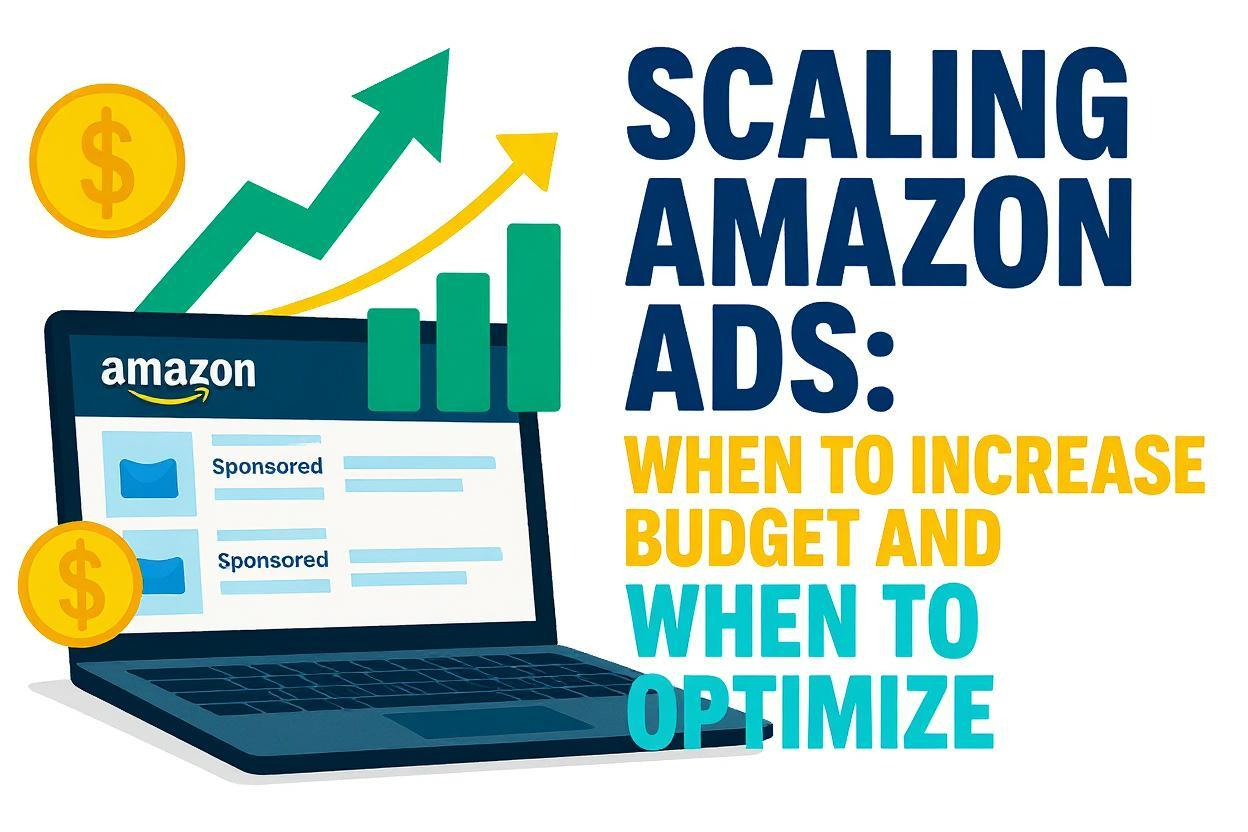
You’ve launched your ads. They’re running. Sales are coming in. But now comes the real question every Amazon seller faces:
Should I scale the budget or optimize first?
Scaling too soon can waste ad spend. Optimizing too late can stunt growth. In this post, you’ll learn when to scale and when to fine-tune-so you can grow sales profitably without burning money.
What Does “Scaling Amazon Ads” Mean?
Scaling means increasing your daily ad budget or expanding reach to drive more impressions, clicks, and (ideally) sales.
But scaling without strategy leads to:
-
Higher ACoS (Advertising Cost of Sales)
-
Lower ROAS
-
Unprofitable campaigns
Before you scale, you must know: Is your current setup ready for more volume?
Step 1: Know If You’re Ready to Scale
You should only scale if your existing campaigns meet these basic health checks:
| Metric | Ideal Threshold |
|---|---|
| ACoS | ≤ 30% (or below break-even) |
| TACoS | Stable or decreasing |
| CVR (Conversion Rate) | ≥ 10% |
| CTR (Click-through rate) | ≥ 0.3% |
| Ad Spend Efficiency | Generating consistent returns |
If these metrics are off, pause and optimize before scaling.
When to Optimize First
Optimization means making your current campaigns more efficient before adding more budget.
Optimize if:
-
ACoS is high (above break-even)
-
Conversions are inconsistent
-
Clicks aren’t turning into sales
-
Budget is being spent on low-converting or irrelevant keywords
Key Optimization Areas:
-
Keyword Tuning
-
Pause underperforming keywords
-
Add high ACoS search terms as negative
-
Promote high-converting exact match keywords
-
-
Bid Adjustments
-
Lower bids for poor-performing placements
-
Increase slightly for profitable terms
-
-
Improve Product Listings
-
Better images = better click & conversion rates
-
Strong bullet points = stronger CVR
-
Add A+ content or video where possible
-
-
Refine Targeting
-
Test new ASIN targeting or audience segments
-
Trim auto campaigns after 10-14 days of data
-
Only after improving efficiency should you consider increasing budget.
When to Increase Budget
Once you’ve optimized, scaling helps you get more of what’s working.
Scale if:
-
You’ve found profitable keywords
-
ACoS is below target or stable
-
Campaigns are getting capped (limited by budget)
-
Organic sales are growing alongside paid (TACoS is improving)
Smart Scaling Strategy:
-
Increase Budget Gradually
-
+10-20% at a time every 3-5 days
-
Monitor results before next increase
-
-
Double Down on Winning Campaigns
-
Exact match campaigns with proven keywords deserve more budget
-
-
Expand Match Types
-
Add Phrase and Broad versions of successful Exact keywords to cast a wider net
-
-
Launch New Campaign Types
-
Sponsored Brands for brand awareness
-
Sponsored Display for retargeting and upsells
-
-
Layer in New Keywords
-
Use Search Term Report and keyword tools to discover new profitable search terms
-
Warning Signs You’re Scaling Too Fast
-
ACoS spikes immediately
-
Budget is spent by noon daily
-
Impressions rise but conversions stall
-
Organic sales drop (you’re replacing, not growing)
If this happens, pause, optimize again, and restart slow scaling.
Scaling vs. Optimizing: A Simple Framework
| Situation | Action |
|---|---|
| Profitable campaigns, low ACoS, high CVR | Scale budget gradually |
| High spend, inconsistent sales | Optimize keywords and bids |
| Low CTR | Improve creative and copy |
| High TACoS | Increase organic traction, optimize listing |
| Ads running out of budget mid-day | Increase budget (if ACoS is healthy) |
Pro Tip: Use Campaign Budget Rules
Amazon allows Budget Rules (based on performance or time of day) to automate scaling safely.
Examples:
-
Increase budget by 20% on weekends
-
Raise spend only if ROAS > 4x
Final Thoughts
Scaling Amazon Ads isn’t about throwing more money at your campaigns-it’s about knowing when and where to invest more.
Focus on:
-
Data-backed decisions
-
Gradual scaling
-
Continuous optimization
And most importantly-watch your TACoS, not just your ACoS.
📞 Want to Scale Without Wasting Spend?
At eCommercean.com, we help Amazon sellers scale with data-first, profitable strategies. From keyword research to full campaign management, we ensure you grow sustainably.
Book your free Amazon Ads audit today. Let’s scale smart.
